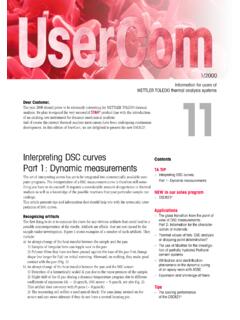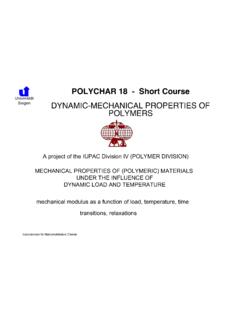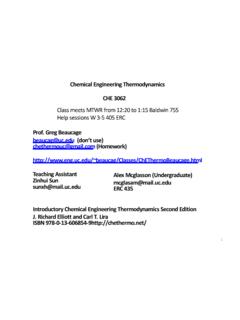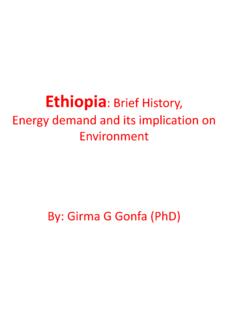Transcription of Cross-linked Polymers and Rubber Elasticity
1 Cross-linked Polymers and Rubber ElasticityChapter 9 (Sperling) Definition of Rubber Elasticity and Requirements Cross-links, Networks, Classes of Elastomers (sections 1-3, 16) Simple Theory of Rubber Elasticity (sections 4-8) Entropic Origin of Elastic Retractive Forces The Ideal Rubber Behavior Departures from the Ideal Rubber Behavior (sections 9-11) Non-zero Energy Contribution to the Elastic Retractive Forces Stress-induced Crystallization and Limited Extensibility of Chains(How to make better elastomers: high Strength and high Modulus) Network Defects (dangling chains, loops, trapped entanglements, ) Semi-empirical Mooney-Rivlin Treatment (Affine vs Non-AffineDeformation)Definition of Rubber Elasticity and Requirements Definition of Rubber Elasticity :Very large deformability with complete recoverability.
2 Molecular Requirements: Material must consist of polymer to change conformation and extension under stress. Polymer chains must be highly to access conformational changes (not w/ glassy, crystalline , stiff mat.) Polymer chains must be joined in a network to avoid irreversible chain slippage (permanent strain).One out of 100 monomers must connect two different (covalent bond, crystallite, glassy domain in block copolymer)Cross-links, Networks and Classes of Elastomers Chemical Cross-linking Process:Sol-Gel or Percolation Transition Gel Characteristics: Infinite Viscosity Non-zero Modulus One giant Molecule Solid Polymer Network Step Polymerization (isocyanates, oxirane) Chain Polymerization (styrene with divinylbenzene) Post-polymerization Reactions (vulcanization with sulfur) Cross-linked and Gels in the Food/Health Care Industry:Globular protein example: the egg white !
3 (S2bridges)Jello , contact lenses, liquid soaps, shampoos (proteins, polysaccharides) Historical Development: Christopher Columbus, 1492 Gough, 1805 Stretching an elastomer leads to its ..Cross-links, Networks and Classes of Elastomers Differentiate Thermosets and Elastomers: Concerned only with Elastomers (Why ? )T > Tgwarming up Historical Development: Christopher Columbus, 1492 Gough, 1805 Stretching an elastomer leads to its .. Under constant load, heating leads , Networks and Classes of Elastomers Differentiate Thermosets and Elastomers: Concerned only with Elastomers (Why ? )T > Tgwarming upshrinkage Historical Development: Christopher Columbus, 1492 Gough, 1805 Stretching an elastomer leads to its .. Under constant load, heating leads Stretching followed by cooling leads to loss of power and density Cross-links, Networks and Classes of Elastomers Differentiate Thermosets and Elastomers: Concerned only with Elastomers (Why ?)
4 T > Tgwarming upshrinkageretractiverise Historical Development: Christopher Columbus, 1492 Gough, 1805 Stretching an elastomer leads to its .. Under constant load, heating leads Stretching followed by cooling leads to loss of power and density Raincoat story, ca. early 19thcenturyCross-links, Networks and Classes of Elastomers Differentiate Thermosets and Elastomers: Concerned only with Elastomers (Why ? )T > Tgwarming upshrinkageretractiverise Historical Development: Christopher Columbus, 1492 Gough, 1805 Stretching an elastomer leads to its .. Under constant load, heating leads Stretching followed by cooling leads to loss of power and density Raincoat story, ca. early 19thcentury Goodyear, 1844 Cross-links, Networks and Classes of Elastomers Differentiate Thermosets and Elastomers: Concerned only with Elastomers (Why ?)
5 T > Tgwarming upshrinkageretractiverise Historical Development: Christopher Columbus, 1492 Gough, 1805 Stretching an elastomer leads to its .. Under constant load, heating leads Stretching followed by cooling leads to loss of power and density Raincoat story, ca. early 19thcentury Goodyear, 1844 Cross-links, Networks and Classes of Elastomers Differentiate Thermosets and Elastomers: Concerned only with Elastomers (Why ? )T > Tgwarming upshrinkageretractiverise Why cross-linking ? Dimensional stability, creep reduction is required in manufactured goods!!!!Cross-links, Networks and Classes of Elastomers Sulfur Vulcanization: Electron or Irradiation Chain Polymerization with a Tetrafunctional ComonomerCross-links, Networks and Classes of ElastomersCommercial Products NBR, SBRB utyl Rubber & EPDMca.
6 Add 2% of and segmented Copolymers Kraton , Lycra , Spandex , Hytrel Caulking, gaskets, O-rings, high T elastomersCross-links, Networks and Classes of ElastomersSegmented Copolymers:Example: Hytrel (DuPont)Hard segment: m = 1, 2 Soft segment: n = 40-60 Cross-links, Networks and Classes of ElastomersTheory of Rubber Elasticity Thermodynamics, Statistical Mechanics and Chain Statistics(Kelvin, Kuhn, Guth, Mark, James, Treloar and Flory) Second Law of Thermodynamics: What happens if you release the stress applied to a Cross-linked coil? A1: Deformation is a Constant Volume Process ( ) A2: Helmholtz Free Energy (F = A = U TS) should be minimized A3: Assume the Internal Energy (U) is independent of deformation Final Answer: the Entropy must be IN PLAIN LANGUAGE: Releasing the stress applied to a Cross-linked Rubber , leads to the coiling back of extended chains, since a retraction allows the chains to adopt higher entropy conformations.
7 RETRACTIVE FORCES ARE ENTROPICIN NATURE IN RUBBERY What about metals ?Theory of Rubber Elasticity Approach and Results: Consider the Gaussian statistics for the distribution of end to end distances. Calculate S, the entropy per chain in terms of <r02>. Calculate F, the free energy change due to deformation (-T S). Assume local and macroscopic deformations are the same (affine deformation). Assume the volume does not change during deformation. Rubbery materials are non-Hookean()()() ==+== = = +== = = = = = = 2202202220222022020,,1123132233,ln,ln22 GrrnRTEGrrnRTErrnRTFrrnRTrdrrnRTWFrkTrrT rkTrFfTrkTUTSUF iiiirrTVVTin = # active chains per unit volume : elongation ratioIdeal Rubber BehaviorTheory of Rubber ElasticityComparison of Experiment and TheoryTheory of Rubber ElasticityTypical CalculationAssume an elastomer of x 10 cm3is stretched to 25 cm length at 35 C, a stress of 2 107dynes/cm2being required.
8 What is the concentration of active network chains and what is the magnitude of the shear modulus?n = 10-4mol/cm3G = J/cm3or G = MPanRTGRTn= =21 Theory of Rubber ElasticityIdeal Rubber Equation of StateTVLVSTVeLVTVLVTVTVTVTVTVTVLSTTfTfLU fTfTLUfTfLSSdTfdLdFLTSLSTLULFfLFfSdTfdLd FSdTTdSdUdFTSUFTdSfdLTdSfdLpdVdUdqdwdU,, ,,,,,,,,,, = = = + = = = = = = = = =+=++ =+=Ideal Rubber EoS0,,= = =TVeLVLUfTfTfTheory of Rubber ElasticityRubber Thermoelastic BehaviorStress required to achieve a given strain at a fixed temperature Rubber sample at different percentage ,,,22021 = = =+= = Theory of Rubber Elasticity Is the behavior of a real elastomer truly ideal ?
9 How do we explain the observation made by Gough (strain leads to a rise in temperature)?pLLppTpLpSVLVTeVLSSeTfCTLSS TLTTfTfLUfTfTffff,,,,,,,, = = = = =+=Departure from Ideal Rubber Behavior Departures from the Ideal Rubber Behavior Non-zero Energy Contribution to Elastic Retractive Forces(previous slide) Stress-induced Crystallization Limited Extensibility of Chains(better elastomers with high strength and high modulus can be obtained when bimodal networks with long and short chain segments are used) Network DefectsThey must be accounted for in the calculation of the modulus. How do we get the true n ?Departure from Ideal Rubber Behavior Non-zero Energy Contribution to Elastic Retractive ForcesdTrdTffTfTfLUfoeVLVTe2,,ln1= = = (dimethyl siloxane) (ethyl acrylate) (ethylene) poly(butadiene) (isoprene) rubberfe/ fPolymer[][]dTddTrdMMroao ln32ln22/32= =Departure from Ideal Rubber Behavior + =32211200 fummHNRTT Stress-Induced Crystallization One of the two possible reasons for up-swing of stress at high strains Modulus increases rapidly as crystals act as new cross-links !
10 Only for crystallizable chains ! Melting point increases with stress (why ?)Departure from Ideal Rubber Behavior +=22112 CC Limited Chain Extensibility As chains extend significantly, the Gaussian Statistics approximation no longer holds. Mooney-Rivlin-Saunders semi-empirical theory allows to extend the predicted stress-strain curves from low to moderate extensions (not high extensions, < see fig. 9-18). How can we make better elastomers ( high strengths, high modulus) ? C1= 2 6 kg/cm2, C2= 2 kg/cm2 2C2/C1measures looseness of network (Flory)Departure from Ideal Rubber Behavior Network Defects Loose Chain Ends (A.), Intramolecular Loops (B.), Entangled Chain Loops (C.) The quantity n in the Rubber Elasticity Theory is the true density of active chain sections between cross-links. It could be calculated from stress-strain curves.









